AMSTERDAM
The second part of my journey took me to Amsterdam in the Netherlands. Out of the six organisations I visited here, two really stood out as programmes I’d hoped I’d discover when planning my research. Both situated in areas with around 80% social housing, they were the central hubs of their respective communities. Utilising and serving both migrant and non-migrant locals, they provided the ‘social bridge’ necessary for the two groups to connect.
Boost and De Meevaart were examples of what can happen when a community is viewed holistically and not siloed into categories.
BOOST
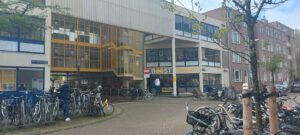
Founded in 2016 by a group of active citizens, within a few months Boost grew into a meeting place for hundreds of newcomers and Amsterdammers from all over the city.
The first part of their mission statement states: “We stand for a society where everyone can participate. Where newcomers are welcomed, and integration is seen as a shared responsibility of society. We believe in the power of the city. That new Amsterdammers and people who have lived in the city for some time can mean a lot to each other in an informal and involved way.”
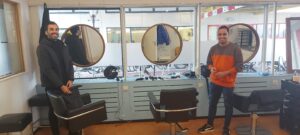
While its focus is on integration, BOOST makes no distinction between migrants and people from the community who were born there – services, and the responsibility for delivering them, are for all. Every week a few hundred participants come to BOOST and mix with people who have lived in the city for longer. They get to know each other, practise the language, do homework, play sports, and develop other talents. Valuable exchange takes place and newcomers get to know Amsterdam society better. The large group of 100+ local volunteers implements the programme.
When locals share ideas of what they would like to do, BOOST supports them in achieving their goals. I met two local Syrians who had set up a small hairdressers in one of the rooms and were offering reduced-price haircuts to anyone in the community.
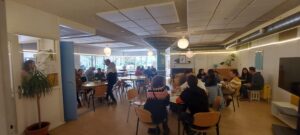
There was a language café, where non-migrant locals would come in, get a coffee, and sit at a table, with the expectation that local people from the refugee community would join the same table and practise speaking Dutch.
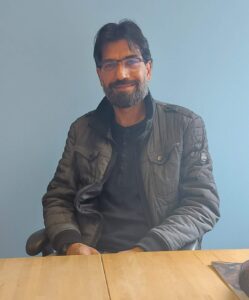 Shahdi
Shahdi
Shahdi, originally a refugee from Palestine, played an important role in the founding of the organisation. When he first arrived in Amsterdam, he felt the locals were wary of him and his friends, and in turn, he didn’t know if the locals would be hostile towards them.
He approached the community centre (as it was at the time) and asked Ramoon, the centre coordinator, if he and his friends could cook lunch for the locals, “We need neighbours to connect, to get to know each other,” he said.
Ramoon agreed, and Shahdi and his friends made some invitations and went round the neighbourhood, inviting the locals to a Middle Eastern lunch.
The locals came, friendships were made, and ‘Boost’ was born.
Linde – Program Manager, BOOST
Unable to meet Linde in person whilst in Amsterdam, I caught up with her over Zoom upon my return.
“BOOST was really a ‘bottom-up’ initiative started by a few guys, including Shahdi, who came here as refugees, and a few people from the neighbourhood. It evolved into a place to connect with other people within the city, so they started implementing some activities. When they increased, we needed and acquired a bigger building.
 Anyone is welcome to join us here, no matter what their current status is, so we see people who have their papers and are allowed to stay. We also see people who are still within the procedure, who are undocumented, and I think that this also makes the space quite unique – a lot of organisations focus on one status or the other; for us, it’s about the ‘broad approach’ based on a research paper that was done in the UK, identifying many aspects of integration.
Anyone is welcome to join us here, no matter what their current status is, so we see people who have their papers and are allowed to stay. We also see people who are still within the procedure, who are undocumented, and I think that this also makes the space quite unique – a lot of organisations focus on one status or the other; for us, it’s about the ‘broad approach’ based on a research paper that was done in the UK, identifying many aspects of integration.
We have an agreement with the local municipality that we have the space we’re in, but maintenance costs are covered by us, which we apply for via different foundations.
We have over a hundred volunteers who serve in a wide variety of roles; they cook lunch, they clean, they do the language coaching, they teach bicycle classes, they organise all of it – there is a team of 9 staff behind the scenes who support them and make sure they can conduct the activities.
We are growing, and the number of participants is growing, and we really also try to motivate people who come to us for, say, a language course, to also get them involved as a volunteer – we really believe that this space is ‘ours’ together; we make it together, we create it together, we shape it together. If anyone has time on their hands and they have a skill or a dream or something to share, we try to create the space for that to happen.
Our mission with the space is to really try and get people to come together, to meet each other, to connect and to exchange; and from there on out, it’s really up to anyone how they fill their time. So, for some people, that might mean they’re here 5 times a week for the entire day, for others, they could come every 3 weeks, and all that is fine. We try to stay away from working with set trajectories that people have to follow; we try to approach it a lot more flexibly. This is what a lot of funding opportunities like about us: the fact that we’re on the other side of that (set trajectories) spectrum.”
De Meevaart
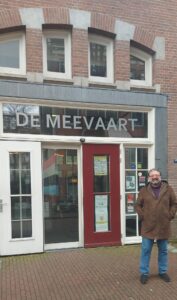 Despite being one of the largest community centres in the Netherlands, their website describes De Meevaart as the ‘living room’ of their local community. I would wholeheartedly agree with this description. From the first minute I entered, I found it to be a very welcoming, relaxed place where everyone was welcome and valued, to the degree that I visited around three more times during my time in Amsterdam.
Despite being one of the largest community centres in the Netherlands, their website describes De Meevaart as the ‘living room’ of their local community. I would wholeheartedly agree with this description. From the first minute I entered, I found it to be a very welcoming, relaxed place where everyone was welcome and valued, to the degree that I visited around three more times during my time in Amsterdam.
It was another place where migrants and non-migrants from the local community could connect, access services and play a key part in delivering them. Approximately 100 organisations make use of De Meevaart. While free to the neighbourhood, De Meevaart generates around 50% of its income from rents charged to outside organisations, a model replicated in other Dutch organisations I visited. It is run by people from the community and has seen 250 citizen initiatives over 6 years. Gathering renown on the world stage, people from 50 other countries have visited to see their work.
Tim Doornewaard CEO
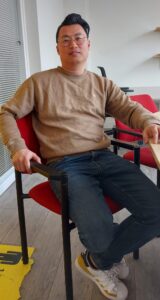 I met with De Meevaart’s CEO, Tim Doornewaard. Tim lives in the local area and started his journey at Meevaart as a volunteer, dedicating one day a week: “The Meevaart is quite unique as it’s one of the largest community centres in the Netherlands (1800 m2). We have a kitchen, a theatre room, a cafe, and a gymnastics room. The other unique point is it’s run by the people who live here, the local citizens.”
I met with De Meevaart’s CEO, Tim Doornewaard. Tim lives in the local area and started his journey at Meevaart as a volunteer, dedicating one day a week: “The Meevaart is quite unique as it’s one of the largest community centres in the Netherlands (1800 m2). We have a kitchen, a theatre room, a cafe, and a gymnastics room. The other unique point is it’s run by the people who live here, the local citizens.”
I asked him how he encourages local people to volunteer, to which he replied: “I think we’ve always been popular as a volunteer place, but that’s also because we offer something; we give something back to the volunteers. So, we have a training program, and we provide them with individual coaching. Because we are such a nice place for volunteers, we don’t have to convince people – last month we even had to turn people away because we ran out of spaces.
Each year, we can offer 15 people our three-days-a-week training program. It’s designed for individuals without certificates or formal education; it’s the first step towards achieving their goals. We focus on language and digital skills. After a year, they are empowered, and we have a large network, so we can assist people in finding jobs they want to do, not have to do.
Everyone is welcome, so we don’t label people; they are all individuals from the local neighbourhood, refugees and non-refugees alike. The roles people can volunteer in range from hosting (welcoming and talking to people), working in the cafe, making teas and coffees, preparing lunch, or cleaning, to being caretakers or managing internet/social media, possibly encompassing more than 20 roles.
We don’t assign fixed roles to people; we prefer to rotate them to avoid monotony. When volunteers come, we learn about them, their interests, and their life goals, and we explore how we can assist them. Most of our funding comes from the municipality; the agreement is that 50% of our rooms need to be used/rented, and the other 50% offered free to the local community. We are required to be open for 74 hours a week. We often have disagreements, but we concur that we need to collaborate.
We aim to provide people with more opportunities to engage in the community in ways that they enjoy, utilising the skills they possess.”
What are your biggest challenges? “We wish to foster a more diverse mix of individuals from the community. Currently, the centre mainly attracts people with low incomes, but we are keen to also welcome individuals with higher incomes and educational backgrounds. We want to foster connections between these groups, but it’s a challenging goal to realise since their available times vary greatly – daytime for those with low income and evenings for those with higher income. Their entire life cycles are completely different.”
Rob Van Der Weelan and Firouz Azarhoosh

Rob and Firouz – two pioneers of Meevaart and Boost, met with me on several occasions. Rob was eager to show me around Amsterdam’s many initiatives that had sprung from these two key centres.
Rob reflected: “Twenty years ago, this area was really bad, with criminality, poverty, poor schools, and health. The national government decided to invest in these types of areas; they were afraid they were becoming ‘no-go areas’. They did so with physical investment; at that time, 80% of houses were social housing. They worked on improving the quality of the houses and social programmes – they said, ‘it will only be a success when people believe again in their neighbourhood.’ They wanted a ‘Participation Program’ in every area.”
Government vision and support have been instrumental in making these initiatives a success. Rob spoke a lot about Ella Vogelaar, the Minister for Housing, Communities, and Integration 2007 – 2008. He attributes her as stating and acting on the declaration: “We will have no left-behind areas; we trust in our citizens. They need spaces to develop their own area. We share the power; politicians and citizens work together. The emphasis on ‘getting tough’ on immigration isn’t the answer.”
Firouz explained the government’s integration process: “You have 3 years to integrate, then you have an exam. You must achieve a certain level of language proficiency and undergo some social orientation, then you receive a certificate of integration, and based on that, you get your state permission.”
During the EU migrant crisis of 2016, Firouz and his wife, Nooshi, felt it very important to ensure that newcomers felt welcome, and that they were also making a contribution. “So, we had Syrian guys running the kitchen; there is another place (Boost) where they repaired bikes and did sewing.”
Rob took me to visit some smaller initiatives born out of De Meevaart and Boost:
Archipel
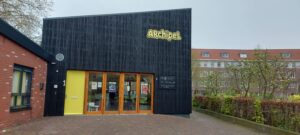 Named after ‘Archipelago,’ or ‘a group of islands,’ The “Archipel” centre is situated in the middle of a diverse social housing estate.
Named after ‘Archipelago,’ or ‘a group of islands,’ The “Archipel” centre is situated in the middle of a diverse social housing estate.
It stands as a testament to what can be achieved through adequate government funding and investment. However, Rob did say that increased bureaucracy and budget cuts are putting this centre, along with others, under threat.
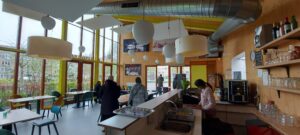
Their objective is ‘connection’, and the centre did just that, serving as a bridge between migrants and non-migrants from the local community. It provided a space where the two could meet and serve the local community together. The centre was run by volunteers, delivering a range of services including language classes, community meals, advice sessions, and a variety of exercise classes.
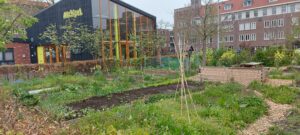
Dappere Dames
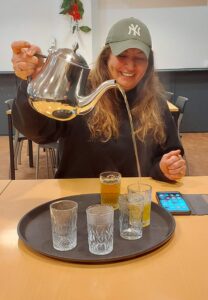
In a smaller community centre a short walk away, a group of Moroccan women were busy making lunch for the local community. They were the ‘Dappere Dames’ or ‘Brave Ladies’.
Services are split into ‘teams’, each delivered by a group of 30 – 35 local volunteers on a weekly basis. These include the information meeting team, the courses team, the kitchen team, and the playground team.
They deliver digital skills classes and Dutch classes, run a soup kitchen (where locals can enjoy a healthy meal at a reduced cost), and offer information and advice sessions, a weekly fun night, coffee mornings, children’s activities, and sewing classes, among others.
VluchtelingenWerk

Different to the other organisations I visited in terms of size, formal structure and central location (not in a local community) I wondered if spending time here would be useful to my research.
I discovered that like the US organisations who were a little more tied to the objectives of their funders, VluchtelingenWerk had devised creative ways in utilising volunteers to provide a holistic ‘wrap around’ service for refugees.
I spent time with Elizabeth Bereket the project lead of their ‘Taal Coach’ (language coach) programme.
Elizabeth had pioneered the programme which now sees around 500 volunteers across Amsterdam supporting refugees in language learning.
So successful was the programme it eventually secured additional funding and became embedded in VluchtelingenWerk’s refugee integration program.
A variety of other volunteer roles were also created supporting job preparation, integration and advice.
Looking back
Most of the organisations I visited demonstrated a holistic approach to ‘community’. I was frequently corrected by my hosts in Amsterdam when I asked if certain key people were ‘refugees’ or ‘Dutch-born locals’ – “we don’t differentiate,” they would tell me. How wonderfully refreshing, when most of what we do in the UK is siloed into groups. Could that be a negative side of our ‘target tick boxes’ culture?
The organisations I met were still riding the wave of government support and backing, but this was under threat, and Firouz talked about increased bureaucracy and impending budget cuts. Dutch politics seemed very fragmented, and at the time of writing, the Dutch Farmer’s Movement holds the sway of power in the national government.
My hope for them is that their roots have gone deep and will help them to stand in any storms to come. They’ve built something of great worth in their local communities, and this will not be easily surrendered by the local people who are in the benefit.

![]()
The views and opinions expressed in this report and its content are those of the author and not of the Churchill Fellowship or its partners, which have no responsibility or liability for any part of the report. All images are the author’s own unless otherwise stated.

